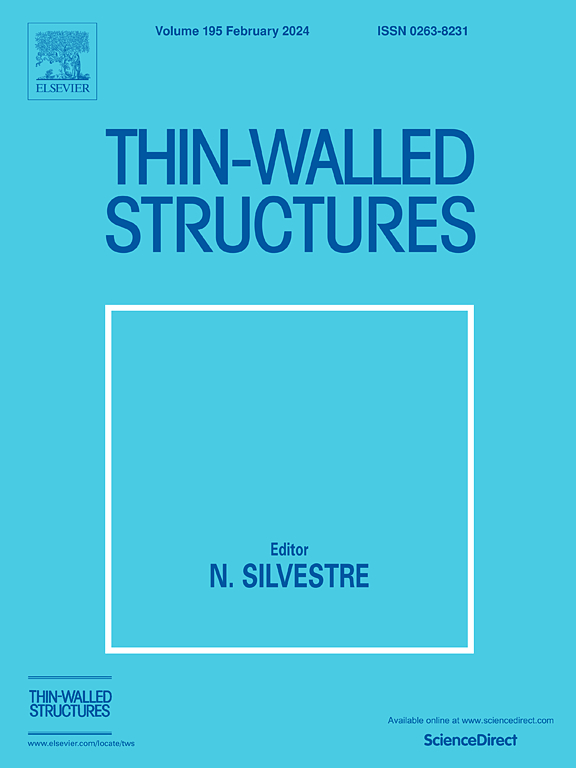抑制碳纤维增强复合材料束内孔隙和调节孔隙形态的高效超声振动策略
IF 5.7
1区 工程技术
Q1 ENGINEERING, CIVIL
引用次数: 0
摘要
在树脂传递模塑(RTM)过程中,束内和束间的树脂流动竞争总是会导致束内气孔的产生,从而削弱复合材料的机械性能。因此,最初开发了一种超声振动策略,以有效抑制和改善 RTM 制造过程中束内气孔的空间形态和分布。系统研究了超声振动对束内气孔空间演变的影响,并进一步揭示了束内气孔的抑制机制。此外,还建立了预测超声振动下孔隙率的经验模型,并对所开发的超声振动策略进行了充分验证,为有效制造复合材料提供了可行的途径。X 射线显微计算机断层扫描实验证实,短时间的超声振动可通过调节修正的毛细管数来平衡双尺度流动,从而显著降低孔隙率,最高可达 59.4%。数值分析表明,超声振动诱发的声空化和声流促进了较大气泡的塌陷和横向迁移,从而显著抑制了连通孔隙和较大孔隙。特别是,超声振动策略完全消除了大于 300 μm 的气孔。此外,振动力、压缩力和剪切力的共同作用有助于形成近圆形气孔,这有利于确保复合材料的预期机械性能。本文章由计算机程序翻译,如有差异,请以英文原文为准。
An efficient ultrasound vibration strategy for suppressing intra-bundle pores and regulating pore morphology in carbon fiber-reinforced composites
The competitive resin flow between intra- and inter-bundles, always causes the generation of intra-bundle pores during resin transfer molding (RTM), thereby weakening composite mechanical performance. Accordingly, an ultrasound vibration strategy is originally developed to efficiently suppress and improve the spatial morphology and distribution of intra-bundle pores in RTM manufacturing. The effects of ultrasound vibration on the spatial evolution of intra-bundle pores are systematically investigated, furthermore, the suppression mechanisms of intra-bundle pores are revealed. Additionally, an empirical model that predicts porosity under ultrasound vibration, is established and well validated for the developed ultrasound vibration strategy, which provides a feasible path for effectively manufacturing composites. X-ray micro-computed tomography experiments verify that applying a short period of ultrasound vibration balances the dual-scale flow by regulating the modified capillary number, thereby significantly reducing porosity by up to 59.4 %. Numerical analyses indicate that the acoustic cavitation and acoustic flow induced by the ultrasound vibration, facilitate the collapse and transverse migration of larger bubbles, thereby remarkably suppressing the connected pores and larger pores. In particular, the ultrasound vibration strategy completely removes the pores larger than 300 μm. Besides, the collective effects of vibration, compression, and shear forces contribute to forming near-circular pores, which are beneficial for ensuring the expected mechanical performance of composites.
求助全文
通过发布文献求助,成功后即可免费获取论文全文。
去求助
来源期刊

Thin-Walled Structures
工程技术-工程:土木
CiteScore
9.60
自引率
20.30%
发文量
801
审稿时长
66 days
期刊介绍:
Thin-walled structures comprises an important and growing proportion of engineering construction with areas of application becoming increasingly diverse, ranging from aircraft, bridges, ships and oil rigs to storage vessels, industrial buildings and warehouses.
Many factors, including cost and weight economy, new materials and processes and the growth of powerful methods of analysis have contributed to this growth, and led to the need for a journal which concentrates specifically on structures in which problems arise due to the thinness of the walls. This field includes cold– formed sections, plate and shell structures, reinforced plastics structures and aluminium structures, and is of importance in many branches of engineering.
The primary criterion for consideration of papers in Thin–Walled Structures is that they must be concerned with thin–walled structures or the basic problems inherent in thin–walled structures. Provided this criterion is satisfied no restriction is placed on the type of construction, material or field of application. Papers on theory, experiment, design, etc., are published and it is expected that many papers will contain aspects of all three.
 求助内容:
求助内容: 应助结果提醒方式:
应助结果提醒方式:


